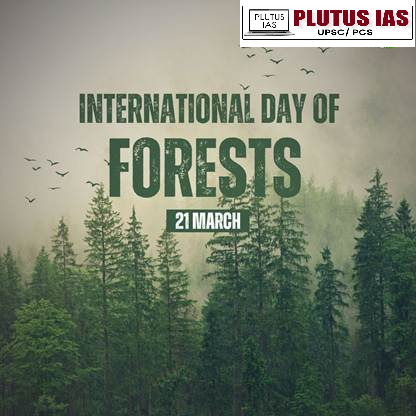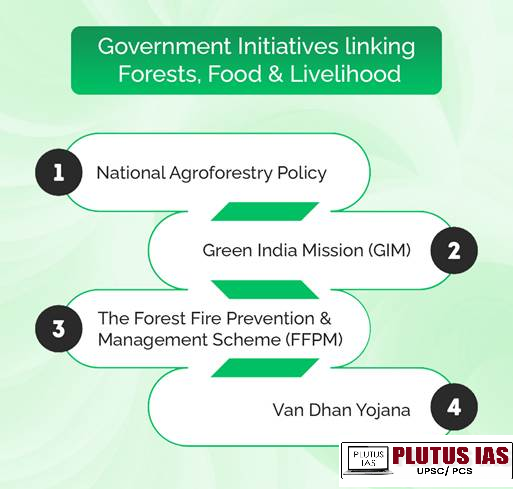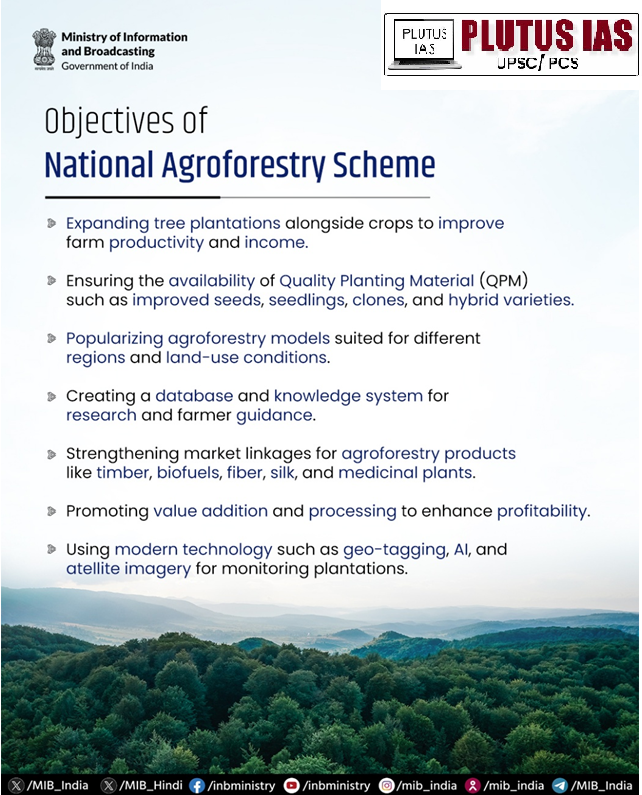26 Mar India’s holistic strategy integrates forests, food, and livelihoods
This article covers “Daily Current Affairs” and the Topic of the India India’s holistic strategy integrates forests, food, and livelihoods
SYLLABUS MAPPING:
GS-3-Environment- India’s holistic strategy integrates forests, food, and livelihoods
FOR PRELIMS
What are the key features of the Green India Mission? and What are the main reasons for deforestation in India?
FOR MAINS
What are the key challenges in implementing the Green India Mission?
Why in the news?
Forests are the lifelines of our planet, providing oxygen, food, medicine, and livelihoods to millions. Beyond their ecological significance, forests are pillars of global food security, offering essential resources such as fruits, seeds, roots, and wild meat, which support indigenous and rural communities. Every year on March 21, the world celebrates the International Day of Forests to celebrate all types of forests, recognize the importance of trees and forests, and take action to protect them.

What is International Forest Day?
International Day of Forests, observed on March 21 each year, is a global event established by the United Nations General Assembly (UNGA) in 2012 to raise awareness about the importance of forests and trees. It highlights the vital role forests play in maintaining ecological balance, supporting biodiversity, and contributing to human well-being. The day promotes actions such as tree planting, conservation efforts, and sustainable forest management to protect these crucial ecosystems. Various organizations, governments, and individuals worldwide participate in activities and discussions that emphasize the need for forest preservation and restoration to combat climate change and ensure a greener future.
Forest Statistics of India
| Category | Details |
|---|---|
| Total Forest & Tree Cover | 8,27,357 sq km (25.17% of India’s area) |
| Forest Cover | 7,15,343 sq km (21.76% of total area) |
| Tree Cover | 1,12,014 sq km (3.41% of total area) |
| Increase in Green Cover (Since 2021) | 1,445 sq km |
| Forest Cover Increase | 156 sq km |
| Tree Cover Increase | 1,289 sq km |
| Top States (Forest & Tree Cover Increase) | Chhattisgarh (684 sq km), Uttar Pradesh (559 sq km), Odisha (559 sq km), Rajasthan (394 sq km) |
| Top States (Forest Cover Increase) | Mizoram (242 sq km), Gujarat (180 sq km), Odisha (152 sq km) |
| Largest Forest & Tree Cover (Area-wise) | 1. Madhya Pradesh (85,724 sq km) 2. Arunachal Pradesh (67,083 sq km) 3. Maharashtra (65,383 sq km) |
| Largest Forest Cover (Only) | 1. Madhya Pradesh (77,073 sq km) 2. Arunachal Pradesh (65,882 sq km) 3. Chhattisgarh (55,812 sq km) |
| Highest Forest Cover (Percentage of State’s Area) | 1. Lakshadweep (91.33%) 2. Mizoram (85.34%) 3. Andaman & Nicobar Islands (81.62%) |
Govt policies for forest protection in India

| Category | Details |
|---|---|
| National Agroforestry Scheme | Encourages farmers to adopt agroforestry for climate resilience, environmental conservation, and economic benefits. |
| Implementation Strategy | Focuses on Quality Planting Material (QPM) through nurseries and tissue culture units. ICAR-Central Agroforestry Research Institute (CAFRI) is the nodal agency. Collaborates with ICFRE, CSIR, ICRAF, and State Agricultural Universities for technical support and training. |
| Market & Economic Support | Provides price guarantees and buy-back options for farm-grown trees. Encourages private sector participation in marketing and processing agroforestry products. Aligns with India’s promotion of millets, which thrive in tree-based farming systems. |
| Funding & Support | Government offers financial assistance for nurseries and research projects. |
| Green India Mission (GIM) | A key initiative under India’s National Action Plan on Climate Change (NAPCC) aimed at expanding, restoring, and enhancing forest cover to combat climate change. |
| Mission Start Year | 2015-16 (FY) |
| Mission Goals | Expand forest/tree cover by 5 million hectares (MHA). Improve the quality of another 5 mha of forest & non-forest land. Enhance carbon storage, water management, and biodiversity. Improve livelihoods for 3 million households through forest-based income. |
| Sub-Missions of GIM | 1. Enhancing Forest Cover: Improving forest quality and ecosystem services. 2. Ecosystem Restoration: Reforesting and increasing forest cover. 3. Urban Greening: Planting more trees in cities and surrounding areas. 4. Agroforestry & Social Forestry: Boosting biomass and creating carbon sinks. 5. Wetland Restoration: Reviving and conserving critical wetlands. |
Forest Degradation in India
1. Deforestation & Land Use Change: Large-scale clearing of forests for agriculture, infrastructure, and urbanization reduces forest cover and biodiversity.
2. Illegal Logging & Timber Extraction: Unregulated tree felling for timber, fuelwood, and commercial purposes leads to habitat destruction.
3. Encroachment & Habitat Fragmentation: Human settlements, farming, and industrial expansion result in fragmented forests, impacting wildlife movement and ecosystem balance.
4. Forest Fires: Both natural and human-induced fires destroy vast forest areas, reducing biodiversity and increasing carbon emissions.
5. Mining & Industrial Activities: Open-cast mining, quarrying, and industrial pollution degrade soil quality and disturb forest ecosystems.
6. Climate Change Impacts: Rising temperatures, erratic rainfall, and extreme weather events stress forests, leading to tree mortality and biodiversity loss.
7. Invasive Species: Non-native plant species, such as Lantana and Parthenium, outcompete native flora, altering forest composition.
8. Overgrazing & Unsustainable Agriculture: Livestock overgrazing and shifting cultivation practices lead to soil erosion and loss of vegetation.
Way forward to Promote forest protection
1. Strengthen Afforestation & Reforestation Initiatives: Expand programs like the Green India Mission (GIM) and Compensatory Afforestation Fund Management and Planning Authority (CAMPA).
2. Enhance Legal and Policy Framework: Strengthen enforcement of the Forest Conservation Act, 1980, and Wildlife Protection Act, 1972. Implement stricter penalties for illegal deforestation and encroachments.
3. Sustainable Forest Management (SFM): Adopt community-based Joint Forest Management (JFM) programs. Encourage eco-tourism and non-timber forest product (NTFP) industries for sustainable livelihoods.
4. Community Participation & Indigenous Knowledge: Involve tribal and forest-dwelling communities in conservation efforts. Recognize traditional ecological knowledge for forest protection.
Strengthen the implementation of the Forest Rights Act of 2006 to balance conservation and community rights.
5. Strict Control on Forest Degradation & Land Use Change: Implement policies to curb deforestation due to urbanization and mining. Promote land reclamation techniques for degraded forests.
Enforce sustainable infrastructure development with minimal ecological damage.
7. Forest Fire Prevention & Control Measures: Use early warning systems and satellite monitoring to detect forest fires. Train local communities for fire prevention and control strategies.
Establish fire lines and deploy fire-resistant species in vulnerable areas.
8. Restoring Degraded Lands & Wetlands: Strengthen programs for watershed management and soil conservation. Restore wetlands, mangroves, and riparian forests for climate resilience.
9. Promote Agroforestry & Sustainable Agriculture: Scale up the National Agroforestry Policy to integrate trees into farmlands. Support farmers with incentives for agroforestry-based practices.
Conclusion
Forest protection is critical for maintaining ecological balance, combating climate change, and sustaining livelihoods. By integrating scientific innovations, legal frameworks, and sustainable practices, India can enhance its forest conservation efforts while ensuring economic and ecological benefits. Multi-stakeholder collaboration, strict enforcement of policies, and community-driven approaches will be essential to safeguarding India’s forests for future generations.
Download Plutus IAS Current Affairs (Eng) 26th March 2025
Prelims Questions
Q. With reference to forest protection initiatives in India, consider the following statements:
1. The Green India Mission (GIM) is one of the eight missions under the National Action Plan on Climate Change (NAPCC).
2. The National Agroforestry Policy aims to integrate trees into farmlands to promote climate resilience and biodiversity.
3. The Forest Conservation Act, 198of 0, primarily focuses on granting land rights to forest-dwelling communities.
How many of the above-given statements are correct?
A. Only one
B. Only two
C. All three
D. None
Answer: B
Mains Questions
Q. Discuss the major causes of forest degradation in India and suggest measures to promote forest conservation and sustainable management. (250 words, 15 marks)





No Comments